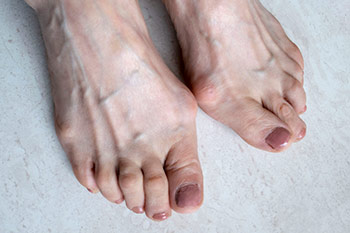
HALLUX RIGIDUS
WHAT IS IT?

Hallux rigidus is a disorder of the joint located at the base of the big toe. It causes pain and stiffness in the joint, and with time, it gets increasingly harder to bend the toe. Hallux refers to the big toe, while rigidus indicates that the toe is rigid and cannot move. Hallux rigidus is actually a form of degenerative arthritis.
This disorder can be very troubling and even disabling since we use the big toe whenever we walk, stoop down, climb up or even stand. Many patients confuse hallux rigidus with a bunion, which affects the same joint, but they are very different conditions requiring different treatment.
Because hallux rigidus is a progressive condition, the toeʼs motion decreases as time goes on. In its earlier stage, when motion of the big toe is only somewhat limited, the condition is called hallux limitus. But as the problem advances, the toeʼs range of motion gradually decreases until it potentially reaches the end stage of rigidus, in which the big toe becomes sti or what is sometimes called a frozen joint.

CAUSES
Common causes of hallux rigidus are faulty function (biomechanics) and structural abnormalities of the foot that can lead to osteoarthritis in the big toe joint. This type of arthritis—the kind that results from wear and tear—often develops in people who have defects that change the way their foot and big toe functions. For example, those with fallen arches or excessive pronation (rolling in) of the ankles are susceptible to developing hallux rigidus. In some people, hallux rigidus runs in the family and is a result of inheriting a foot type that is prone to developing this condition. In other cases, it is associated with overuse, especially among people engaged in activities or jobs that increase the stress on the big toe, such as workers who oen must stoop or squat. Hallux rigidus can also result from an injury, such as stubbing your toe. Or it may be caused by inflammatory diseases, such as rheumatoid arthritis or gout. Your foot and ankle surgeon can determine the cause of your hallux rigidus and recommend the best treatment.

SYMPTOMS
Early signs and symptoms include:
- Pain and stiffness in the big toe during use (walking, standing, bending, etc.)
- Pain and stiffness aggravated by cold, damp weather
- Difficulty with certain activities (running, squatting)
- Swelling and inflammation around the joint
As the disorder gets more serious, additional symptoms may develop, including:
- Pain, even during rest
- Difficulty wearing shoes because bone spurs (overgrowths) develop
- Dull pain in the hip, knee or lower back due to changes in the way you walk
- Limping (in severe cases)

TREATMENT
Treatment approaches for Achilles tendinitis or tendonosis are selected on the basis of how long the injury has been present and the degree of damage to the tendon. In the early stage, when there is sudden (acute) inflammation, one or more of the following options may be recommended:
- Immobilization. Immobilization may involve the use of a cast or removable walking boot to reduce forces through the Achilles tendon and promote healing.
- Ice. To reduce swelling due to inflammation, apply a bag of ice over a thin towel to the affected area for 20 minutes of each waking hour. Do not put ice directly against the skin.
- Oral medications. Nonsteroidal anti-inflammatory drugs (NSAIDs), such as ibuprofen, may be helpful in reducing the pain and inflammation in the early stage of the condition.
- Orthotics. For those with overpronation or gait abnormalities, custom orthotic devices may be prescribed.
- Night splints. Night splints help to maintain a stretch in the Achilles tendon during sleep.
- Physical therapy. Physical therapy may include strengthening exercises, soft-tissue massage/mobilization, gait and running re-education, stretching and ultrasound therapy.

WHY CHOOSE A FOOT AND ANKLE SURGEON?
Foot and ankle surgeons are the leading experts in foot and ankle care today. As doctors of podiatric medicine – also known as podiatrists, DPMs or occasionally “foot and ankle doctors” – they are the board-certified surgical specialists of the podiatric profession. Foot and ankle surgeons have more education and training specific to the foot and ankle than any other healthcare provider.
Foot and ankle surgeons treat all conditions affecting the foot and ankle, from the simple to the complex, in patients of all ages including Haglund's deformity. Their intensive education and training qualify foot and ankle surgeons to perform a wide range of surgeries, including any surgery that may be indicated for Haglund's deformity.

